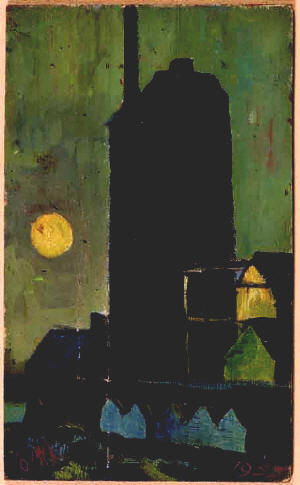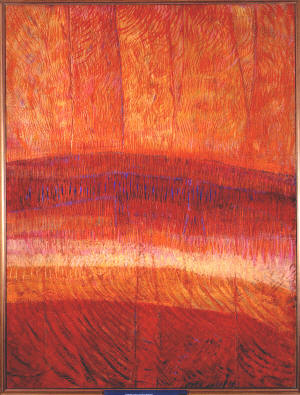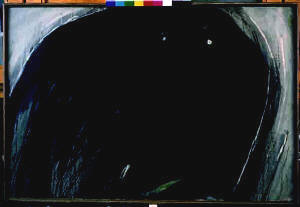 |
||
| home | features | exhibitions | interviews | profiles | webprojects | gazetteer | links | archive | forum | ||
|
Tony O’Malley Tate St Ives, Summer 2006
O’Malley took up painting in his mid-thirties whilst recovering from tuberculosis. Having been born and bred in Ireland, his first visit to St Ives was in 1955. He moved there permanently in 1960, aged 47 to take up painting full-time. In the first gallery, alongside work by 1st and 2nd generation St Ives artists, were three relatively modest early oil paintings, including one: ‘The Old Gasworks’ (1955), painted during this first visit (right). Some of the larger more exuberant paintings for which he is better known were hung on the stairs going down to the Lower gallery overlooking the beach. This included Ripe Cornfield in the Wind (1966) (below), with crosshatched brush-marks in ochre and sienna, and the impressive Spring – pond and sky (1997) reminiscent of Monet’s garden paintings. In the main space of the Lower Gallery hung Kyledoher (1996), an evocative vertical veil of browns and pinks flecked with flashes of yellow, and three impossibly bright horizontal Bahamas paintings from a similar period, with trademark spikey bird and leaf shapes in pastel colours.
Every year O’Malley made at least one work to celebrate Good Friday, and three of these were shown together in the small apse that led on to John Hoylands show which was running concurrently. They suitably shared a more sombre mood, and the browns, blacks and reds of a 17th century altarpiece. O’Malley’s work has an intimate and gentle quality that seems unashamedly domestic in its scale and subject matter. Certainly at a formal level it seemed to struggle to assert itself in the main gallery overlooking the beach - probably for this reason. (The more muscular Hoyland paintings had the better lit, spaces on the side of the gallery away from the beach). At a thematic level, however, there was a rightness to it. In a sense O’Malley is a good artist for this difficult space because his work reflects the reality of a place like St Ives: the colours and pure natural forms are beautiful, but so too - in a different way - are the people and birds that inhabit them, and they cannot be ignored.
This may be both a failing and a strength. Without the benefit of a debate that gives it political or spiritual power abstract art, especially painting, can become empty and decorative. By the 60s and 70s the ideals that drove mid-century abstraction and constructivism had lost a lot of their force, and this is what O’Malley would have been up against. His strategy seems to have been to look to the past, and, with his pointillistic brushwork, hark back to Bonnard and the impressionists. In the context of the St Ives Tate now, he can be viewed as an artist whose work, whilst out of pace with much of the international art of the 70s and 80s, suggested a way out of the impasse of the drive to pure abstraction (a drive perhaps unique to Cornish modernism), that ultimately had led other St Ives artists away from the real world and from lived experience.
RW August 2006
|


